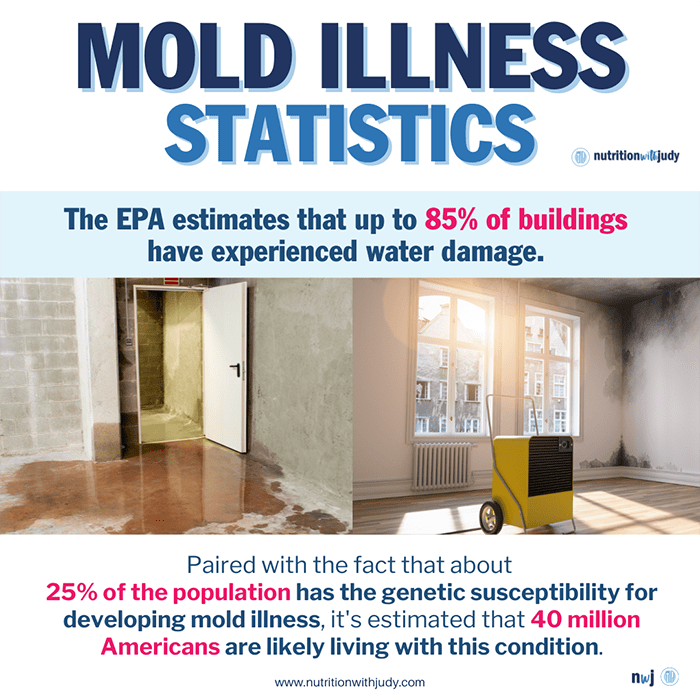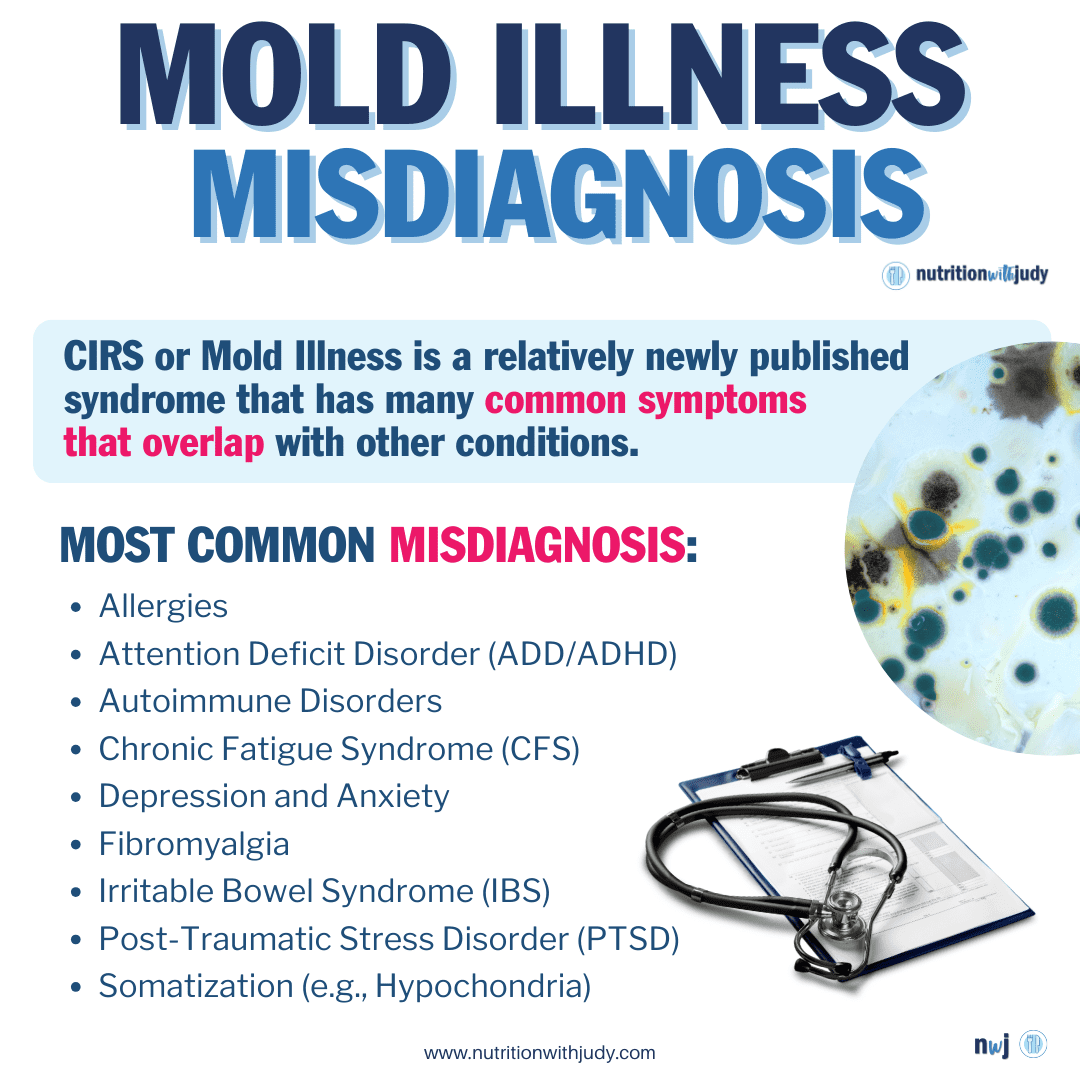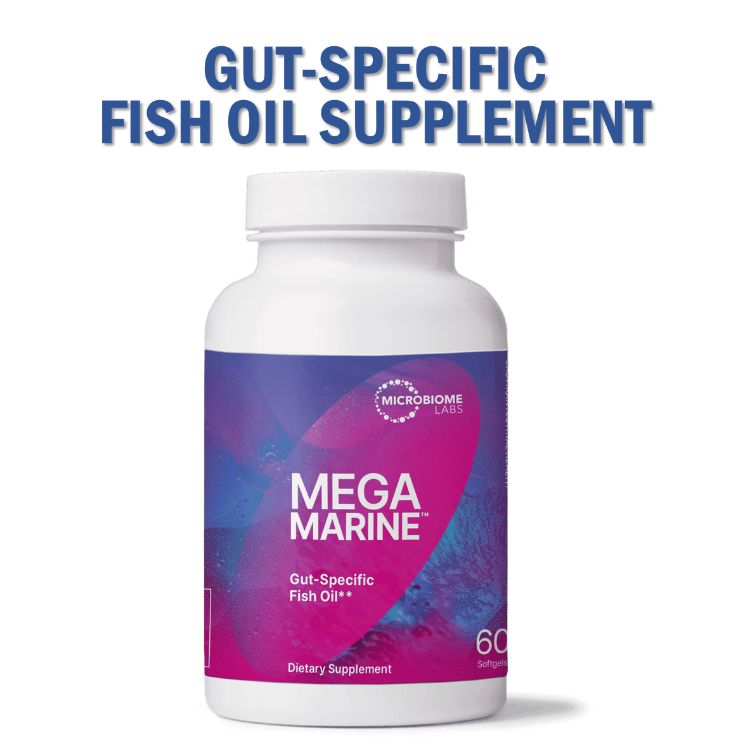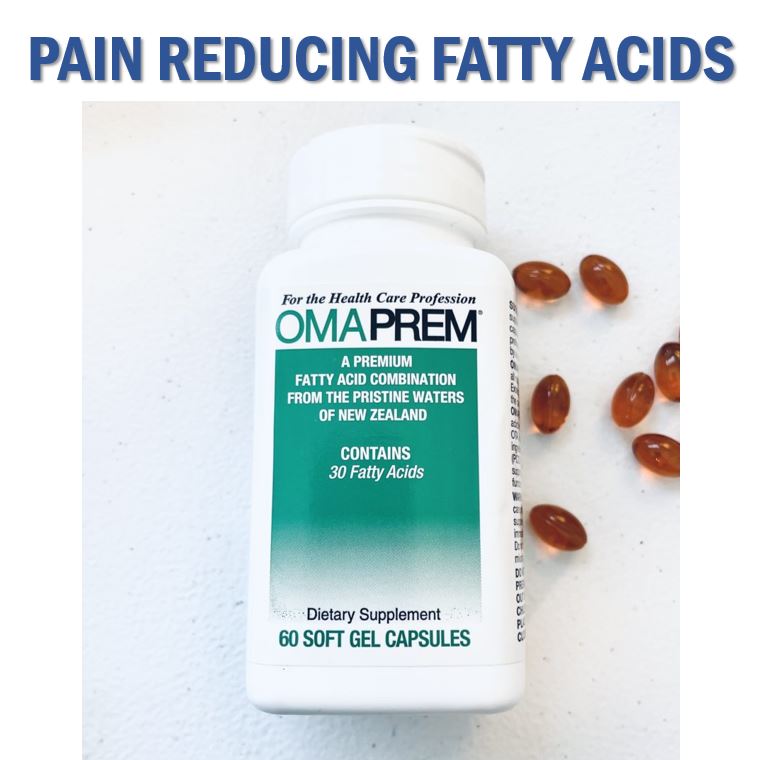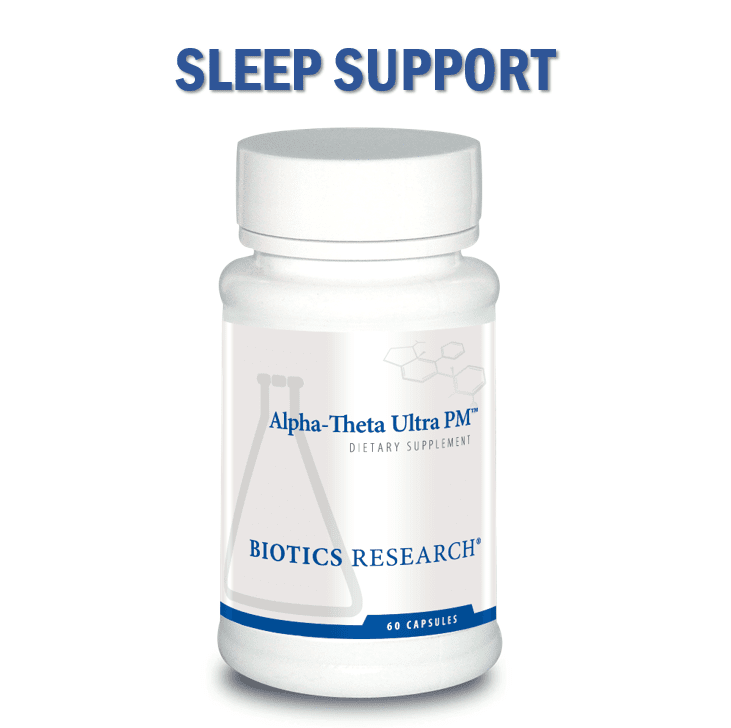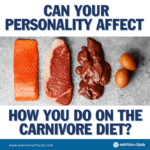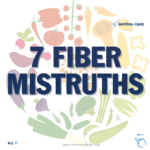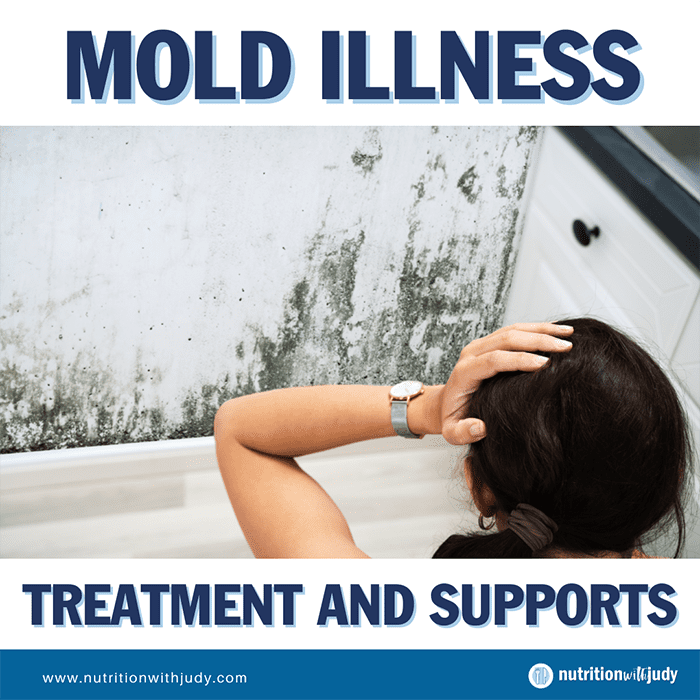

Mold Illness Treatment and Supports


We’ve been sold the idea that mold really isn’t a problem unless it’s the infamous visible black mold variety. We’ve also been told that mildew is a safe kind of mold that we don’t need to worry about if we smell it on our clothing or in our homes. However, what we’re finding is that the mold story is similar to how red meat has become demonized. Frankly, it’s a lie.
Any water damage that creates biotoxins is hazardous to our health. If we think about it logically– what is the purpose of mold? It breaks down and decomposes life in order to create new life. So, what do you think it does in the human body?
During our many years in clinical practice, we’d see how much the carnivore diet can heal yet there was always a small percentage of people that would never fully heal or regain optimal health. This led us down the rabbit hole as we’ve always fought for root-cause healing. What we discovered is that mold illness is very real and the missing piece of the puzzle for the many in our small percentage of patients still working to reclaim their health. This research led to Chronic Inflammatory Response Syndrome (CIRS) and the only peer-reviewed, scientifically published, reproducible protocol by Dr. Ritchie Shoemaker. Mold illness is a subset of CIRS, and both terminologies are often used synonymously. For those looking for answers to mystery illnesses and symptoms, especially if you’ve been on the carnivore diet for six months or more and not experiencing the healing expected, it may be time to look into mold illness. Learn more about mold illness, the only scientifically-proven treatment protocol available, and additional support for your healing journey.
What Is Mold Illness?
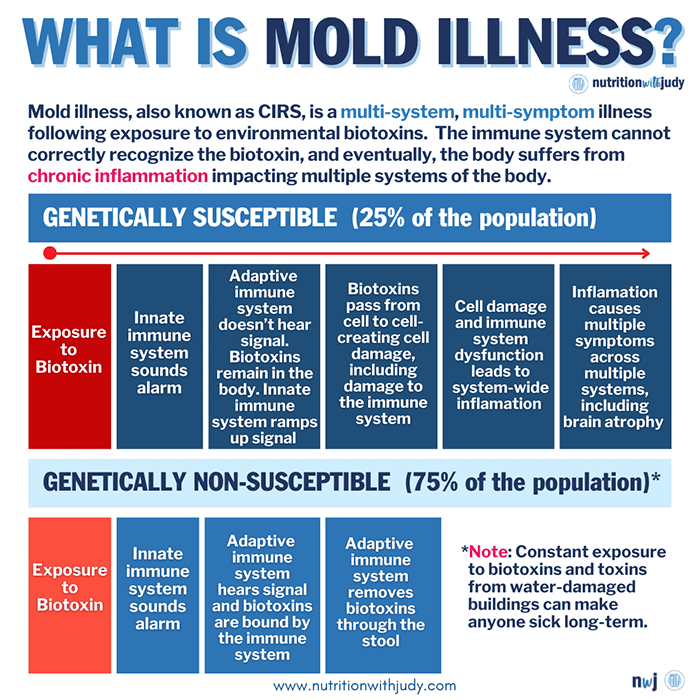

Mold illness, also known as CIRS, is a complex multi-system, multi-symptom disease caused by general inflammation due to an immune response that’s triggered by mold. Technically, mold illness is a subcategory of CIRS but the terms are often used interchangeably since about 80% of CIRS cases are caused by water-damaged building (WDB) molds. Mold illness research conducted by Dr. Shoemaker, the pioneer of biotoxin illness, since 1997 has completely transformed our understanding of mold toxicity along with some of the root causes of chronic conditions and autoimmunity. Here is Dr. Shoemaker’s scientific definition of mold illness or CIRS:
“An acute and chronic, systemic inflammatory response syndrome acquired following exposure to the interior environment of a water-damaged building with resident toxigenic organisms including, but not limited to fungi, bacteria, actinomycetes, and mycobacteria as well as inflammagens such as endotoxins, beta glucans, hemolysins, proteinases, mannans, and possibly spirocyclic drimanes; as well as volatile organic compounds.”
Learn more in-depth about the science behind mold illness here.
Why Do Only Some People Get Mold Illness?
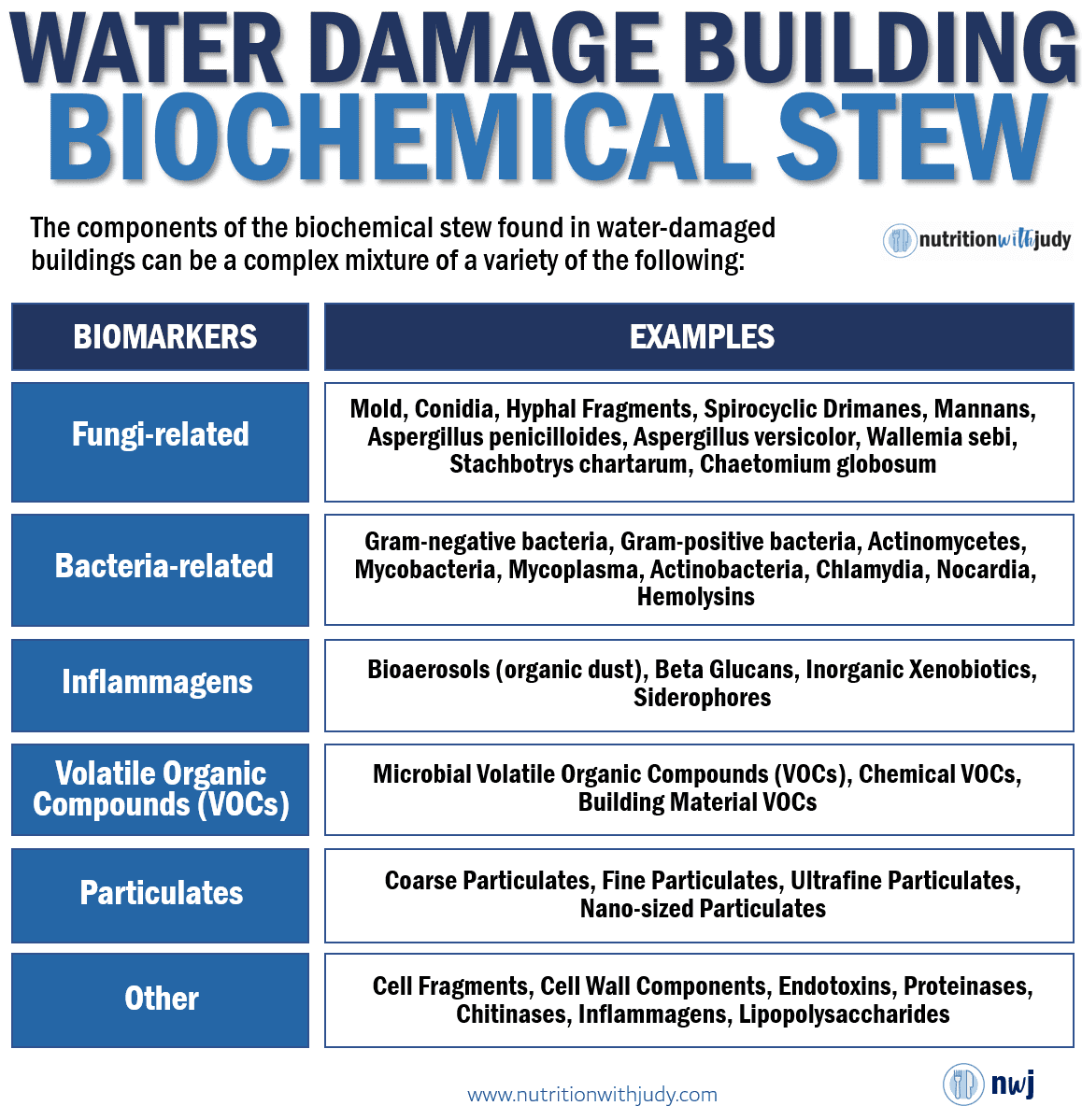

While mold has been documented to cause a wide selection of acute conditions ranging from respiratory infections and bronchitis to cancer, how come only some people experience chronic symptoms and illness from mold exposure?
Approximately 25% of the population is estimated to have a genetic susceptibility to mold illness. This portion of the population is born with HLA-DR genes, meaning their immune system isn’t able to correctly identify the mold pathogens and detox them on their own. Both genetic susceptibility and experiencing a traumatic event in order to turn on the gene expression are required prior to WDB mold exposure in order for mold illness to develop. Outside of this genetic susceptibility, other health and lifestyle factors are also at play– about 5% of mold illness patients don’t have the genetic susceptibility.
Since all the various compounds and fragments from mold are extremely small in size, they’re capable of transporting from cell to cell via the cell membrane and can cross the blood-brain barrier (BBB). The research clearly shows it’s not just live, viable, or intact molds, but also old and dead mold spores broken down into even smaller fragments that make us really sick by passing the BBB.
Mold Illness Statistics and Misdiagnoses
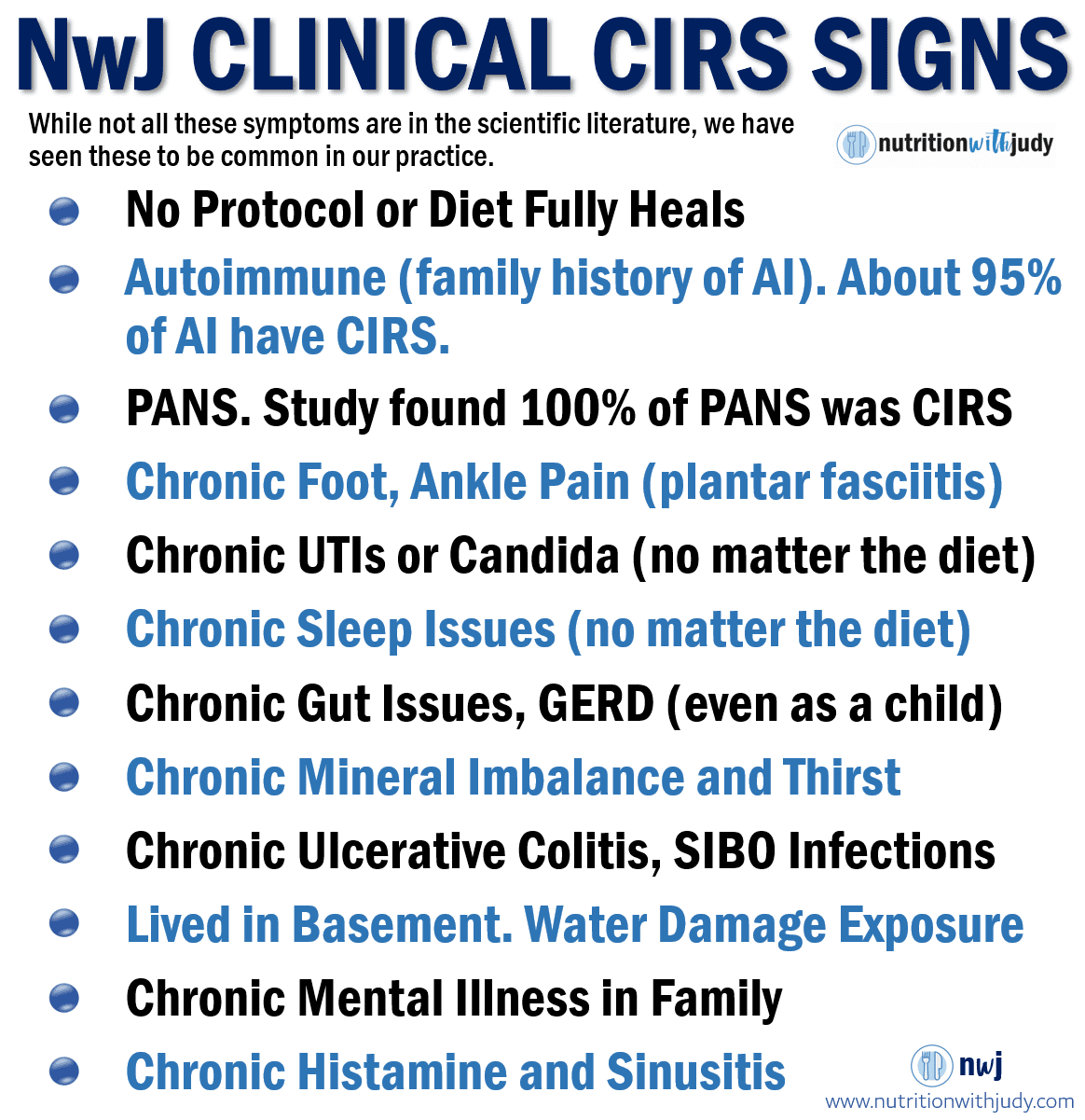

The EPA estimates that up to 85% of buildings have experienced water damage. Paired with the fact that about 25% of the population has the genetic susceptibility for developing mold illness, it’s estimated that up to 40 million Americans are likely living with this condition.
In addition to the complexity of this illness and various diagnostic criteria, CIRS is a relatively newly published syndrome. That means that there’s a lack of awareness in both standard care and holistic wellness spaces. Mold illness symptoms, subsequent downstream effects, and secondary conditions stemming from this root-cause condition are often confused with other illnesses. Here are some of the common misdiagnoses for mold illness:
- Irritable Bowel Syndrome (IBS)
- Post-Traumatic Stress Disorder (PTSD)
- Chronic Fatigue Syndrome (CFS)
- Fibromyalgia
- Attention Deficit Disorder (ADD/ADHD)
- Autoimmune Disorders
- Depression and Anxiety
- Allergies
- Somatization (e.g., Hypochondria)
While mold illness is more discussed and validated in holistic and functional care, the mold space is inundated with noise from different approaches and detoxification methods. In reality, the Shoemaker protocol is the only scientifically proven treatment for mold illness and all other holistic approaches are not clinically proven.
What Are the Symptoms of Mold Illness?
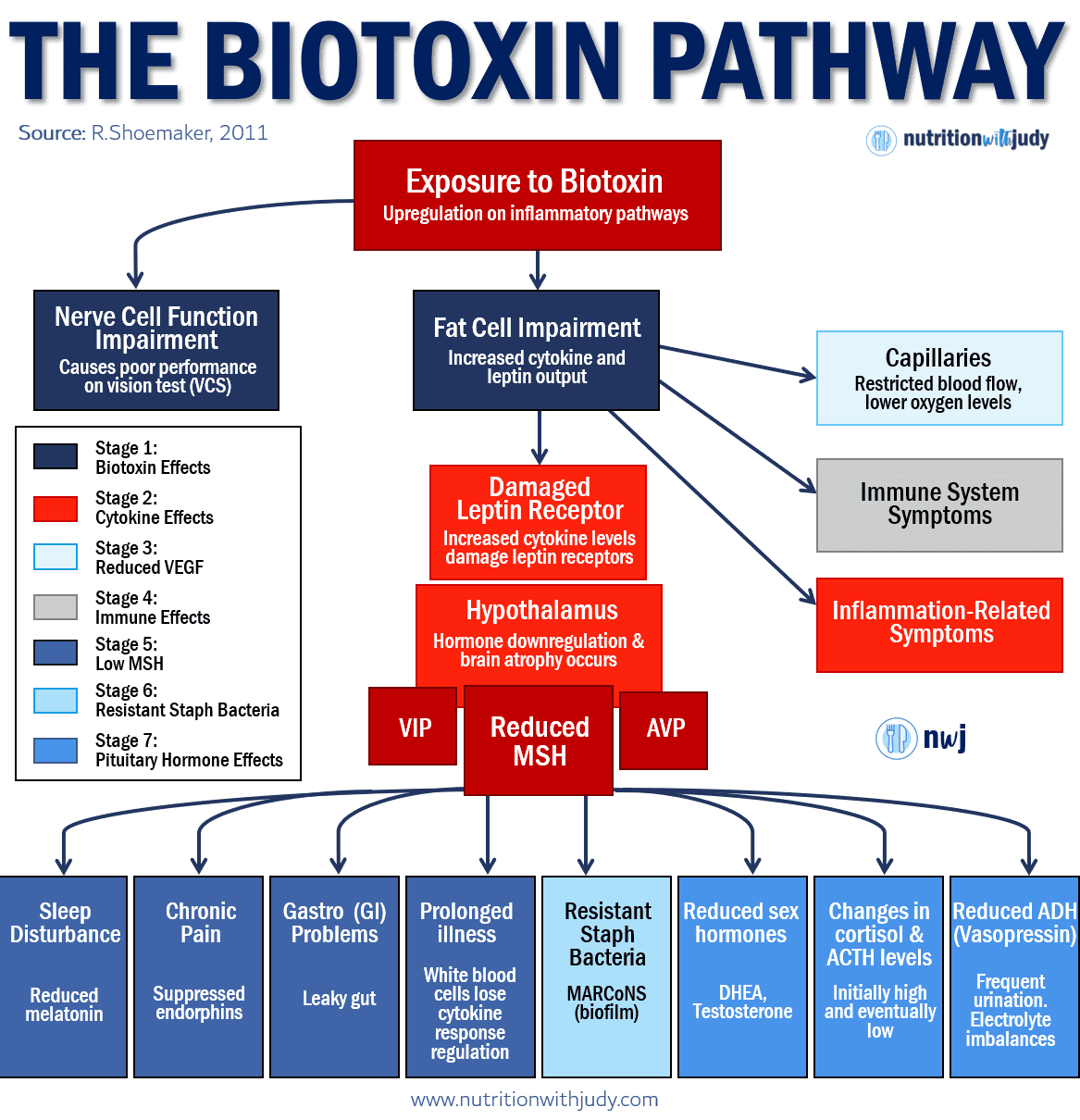

Since mold illness impacts multiple systems in the body through the biotoxin pathway, it can cause a wide array of symptoms that manifest differently from individual to individual.
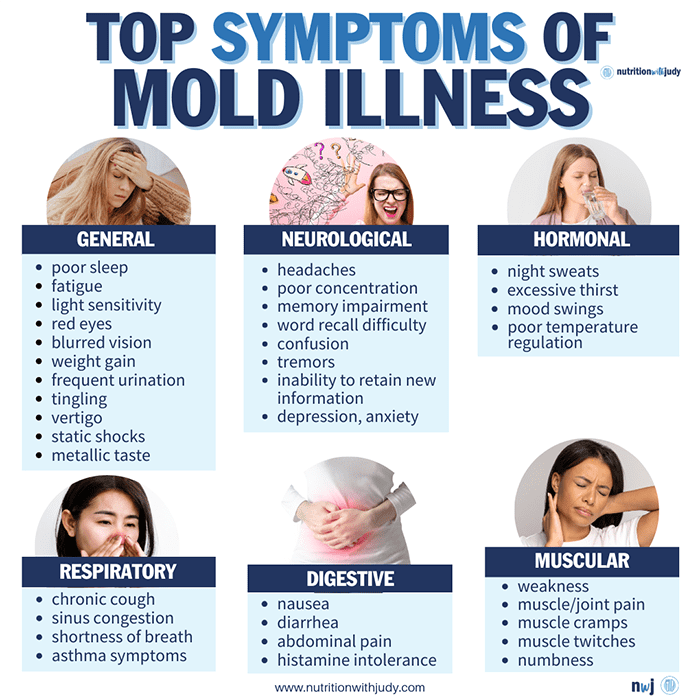

Here are some of the common symptoms of mold illness:
- Muscle cramps and aches
- Ice pick or unusual pain
- Joint pain
- Headaches
- Weakness
- Fatigue
- Non-restorative sleep
- Light sensitivity
- Blurred vision
- Red eyes
- Sinus problems
- Cough
- Shortness of breath
- Diarrhea
- Nausea
- Abdominal pain
- Confusion
- Poor memory
- Poor recall of words
- Concentration issues
- Weight gain
- Depression and anxiety
- Mood swings
- Night sweats
- Dysregulated body temperature
- Frequent urination
- Excessive thirst
- Tremors
- Tingling
- Vertigo
- Histamine intolerance
- Static shocks
- Metallic taste
Since many of these symptoms overlap with other conditions, that’s one of the reasons why mold illness is commonly misdiagnosed. Symptomology is also an essential piece of the diagnostic criteria– the Shoemaker protocol has set symptom clusters based on physiological systems, which we’ll explain more about below.
How Do You Diagnose Mold Illness?
Due to the nature of this condition, there are multiple steps required in the diagnostic criteria for mold illness:
Criterion One: History of Water-Damage Mold Exposure
Many people overlook or forget water damage exposure for a variety of reasons. From being unable to visibly see mold to having common memory problems due to neurological inflammation caused by mold, it’s easy to think you’ve never been in a water-damaged building. Think about all the homes you’ve lived in, schools you attended, your workplace history, and any other buildings you frequently visited.
With around 85% of buildings having water damage, this is likely something you’ve encountered. It only takes 48 hours for mold to grow with the right conditions (e.g., water leak, high indoor humidity).
Here are some water damage event examples: plumbing leaks, broken pipes, property flooding, washing machine overflow, roof hail damage, clogged toilets, and groundwater seepage. Even if you don’t remember having a history of water damage building exposure, the other criteria are much more significant for diagnosis.
Criterion Two: Mold Illness Symptoms
All of the common mold symptoms are grouped into 13 independent clusters due to how they’re caused by the biotoxin pathway. Individuals with symptoms in at least eight of the 13 clusters should move on to the next criterion. Even though there are multiple symptoms in each cluster, you only need one of those symptoms for the entire cluster to be considered positive.
Pro Tip: We’ve experienced in clinical practice that there are many individuals on a carnivore diet who meet all the other diagnostic criteria for mold illness yet do not have eight of the 13 clusters. The carnivore diet is the most anti-inflammatory diet and is a powerful tool for helping temporarily band-aid some of these symptoms. If you haven’t reclaimed your full health after being on the carnivore diet for six months or more and don’t have symptoms in at least eight of these clusters, we still recommend testing the next criterion.
Criterion Three: Visual Contrast Sensitivity (VCS) Test
The VCS test is the next criterion to address for mold illness. It was developed to discern if you can distinguish between varying low contrast levels as a marker of neurological function. The VCS test was originally created by the Air Force in the 1960s as an objective for biomarker pilot health and is still utilized today. The test displays a series of images with decreasing contrasts taken over ten to 15 minutes.
The VCS test can be taken for the first time free here or you can use the official test option from Dr. Shoemaker for a nominal fee here.
Pro Tip: Approximately 8% of mold illness patients falsely pass the VCS test. This is more common for women and those in the creative arts fields. However, individuals who have eight or more of the positive symptom clusters from above that also fail the VCS test have a 98% chance of a positive mold illness diagnosis. If you’ve been on a carnivore diet, don’t have eight out of the 13 positive symptom clusters, pass the VCS test, but still have mystery symptoms or illness that you’re dealing with, you may still want to move onto criterion four. You can always contact our NwJ team if you’re uncertain if you should move on to lab work.
Criterion Four: Mold Illness Lab Work
One of the lab tests needed is the HLA-DR which determines if you have the genetic susceptibility for mold illness. While rare and as mentioned above, a person who doesn’t have the HLA genes can still develop mold illness. This presents for about 5% of all mold illness cases.
These are the following blood markers needed:
- MMP-9
- VEGF
- C4a
- TGF Beta-1
- MSH
- VIP
Learn more about what each of these markers represents here.
Pro Tip: Providers may choose to test additional blood markers so they can get a holistic view of all the downstream effects created by mold illness. These are the essential markers needed to finalize the diagnosis and are also used to track treatment progress throughout the duration of the protocol. We offer the full panel blood work as well as a limited version for those with financial constraints.
What About Mycotoxin Urine Tests?
Many functional doctors argue that you can use mycotoxin urine tests to confirm a mold illness diagnosis. This testing is flawed since there is no control data. What amount is normal and not normal? What is a healthy response? Should certain foods or environments be omitted first? If there are zero mycotoxins in the results, is this truly a negative test? What if there is a positive result? What if you had moldy coffee or grains the night before, could this be a healthy response? Now some practitioners may have their patients take a heavy dose of NAC or glutathione to support clearance of mycotoxins, but what amount is healthy with these supplements? At what point of retesting do we say, yes, we are finally clear of mycotoxins? If it’s purely based on symptoms, was the mycotoxin test ever fully valid? What if we cleared enough to feel better but not fully healed?
While the urinary mycotoxin test provides some level of data, the aforementioned points are the primary issues against using it as the primary data point for mold testing.
This is why it’s imperative to go through the Shoemaker diagnostic criteria in order to gain an accurate mold illness diagnosis, as all markers have control points and, in tandem, meet a differential diagnosis for CIRS. We’ve had patients who had zero mycotoxins show up on their urine tests but were confirmed with mold illness through the Shoemaker diagnostic criteria– we assume this is because their bodies were not detoxing at all on their own due to the genetic haplotype.
How Do You Treat Mold Illness?
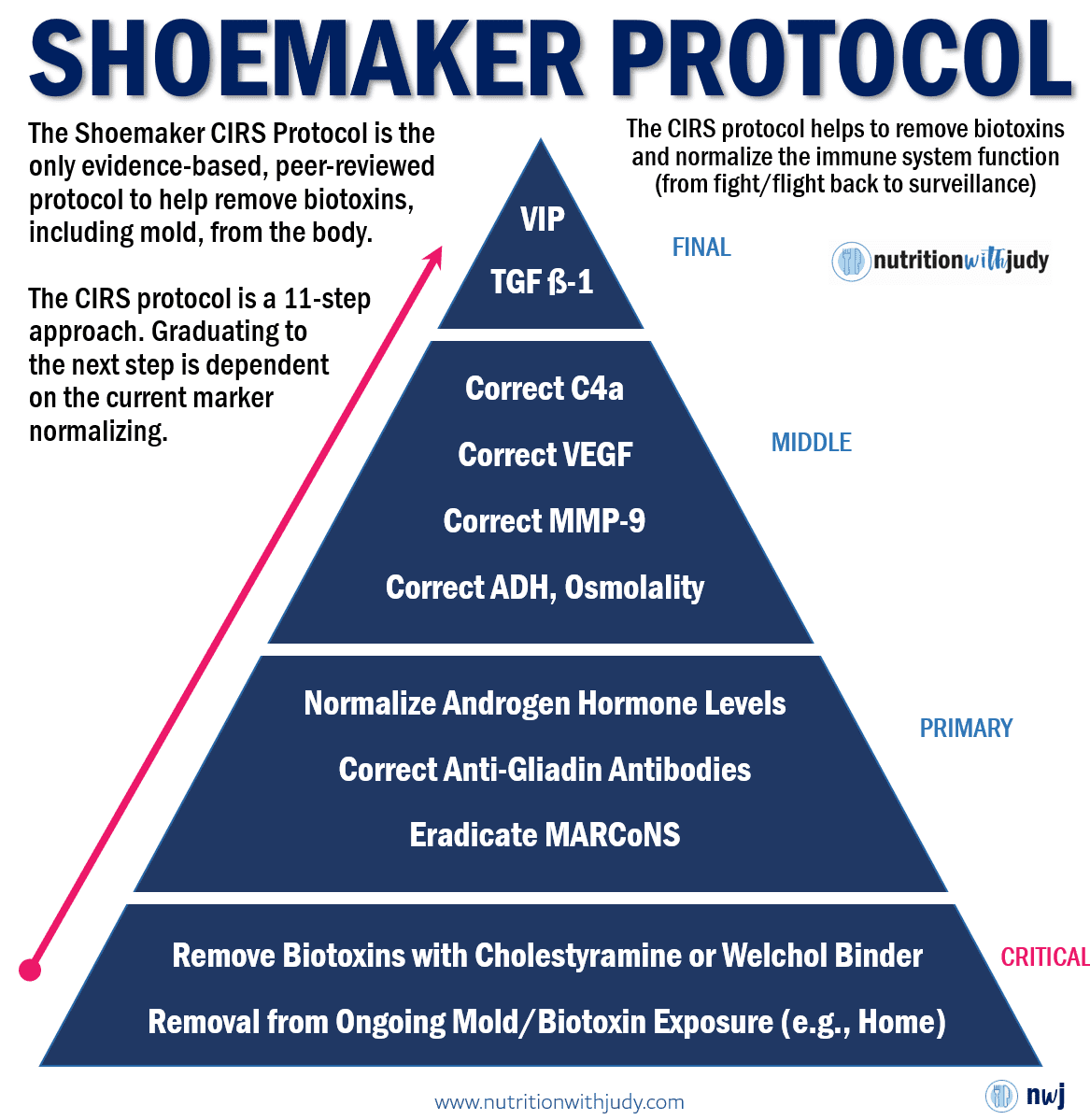

There are many different approaches to mold illness in both standard care and functional medicine spaces. However, the CIRS Shoemaker Protocol developed by Dr. Shoemaker is the only clinically proven, peer-reviewed treatment for mold illness and has successfully treated tens of thousands of patients worldwide. The Shoemaker Protocol is an 11-step approach that addresses each corresponding stage of the biotoxin pathway in order to correct all of the consequences caused by WDB mold exposure.
You can work with us to get started on the Shoemaker protocol. You can start with our CIRS White Glove Service for all the resources and diagnostic criteria you need, or you can simply start with the CIRS diagnostic bloodwork. Judy Cho, our head nutritional therapist, is a proficiency partner under Dr. Shoemaker and has extensively trained the NwJ team.
The Importance of the Shoemaker Protocol
The best way to support the body from mold exposure in water-damaged buildings is to leave the building until it can be remediated or find a new, safe environment. However, there is a distinct difference between individuals with mold illness or CIRS and non-CIRS people when it comes to getting out of exposure. The CIRS people cannot remove the biotoxins on their own.
So, just because you left a bad building, you may feel better because you’re no longer in ongoing exposure– but until you go through the Shoemaker protocol, you will not get to root-cause healing.
No diet, biohack, or supplement will get you there. Even though we highly recommend the carnivore diet for those suffering from mold illness as it helps lower certain inflammatory markers and some symptoms, it’s important to understand that not even the carnivore diet can offer root-cause healing for this specific illness. Yes, getting out of exposure and eating a low-inflammatory carnivore diet will help you feel better. But oftentimes, it is short-lived and symptoms start to come back.
In terms of binders, many holistic and functional doctors advocate for natural options such as activated charcoal, bentonite clay, and humic acid. However, the Shoemaker Protocol’s prescription medications, cholestyramine (CSM) and welchol are essential for proper mold and biotoxin detoxification. These medications have a unique affinity for binding mold because they have a strong positive charge that effectively binds to negatively charged biotoxins. The natural binders mentioned above are negatively charged and, therefore, aren’t capable of directly binding to mold particles within the body.
While beetroot and okra have been found to bind to some of the mold particles and fragments, it would require pounds of both vegetables to be remotely similar to the potency of CSM and welchol. Note that both plants also have their levels of oxalates that can exacerbate fungal production in the body.
Mold Exposure Supports
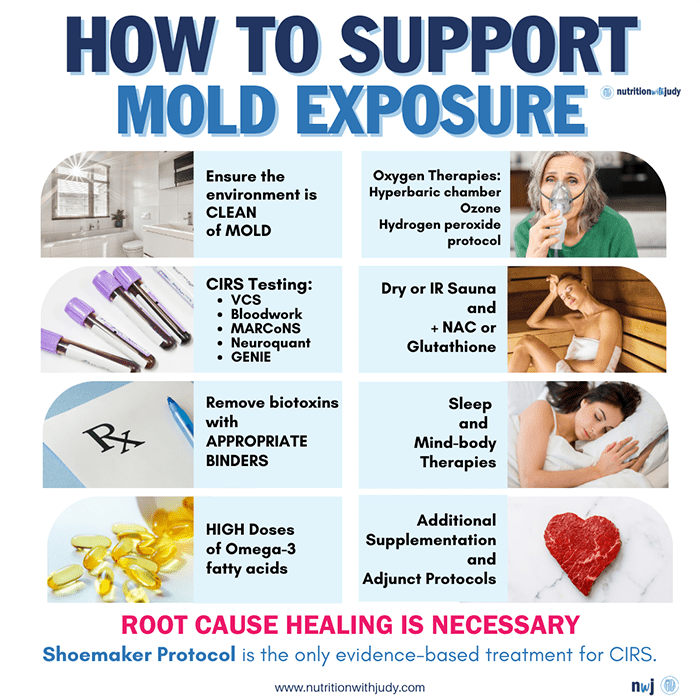

Whether you’re in active treatment or suspect mold exposure, there are different supports available. Ensuring your environment has safe levels of mold and using the appropriate binders are both fundamental for mitigating the effects of any WDB mold exposure.
While these don’t offer root-cause healing, there are additional mold exposure supports available that can help better manage symptoms:
- Oxygen therapies: Oxygen therapies such as the hyperbaric oxygen chamber, ozone, and hydrogen peroxide protocol may offer temporary pain and other symptom relief. However, not everyone tolerates these therapies.
- Supporting drainage pathways: Dry sauna, infrared sauna, dry brushing, lymphatic massage, cupping, and castor oil packs are all different ways that can help open up drainage pathways to better support the body while it detoxes. If you tolerate NAC or glutathione, you can consider pairing those supplements with some of these practices.
- Eat a cleaner carnivore diet: Dialing in on a stricter carnivore diet variety (phase 1 of Carnivore Cure) can also help support the body while you heal from mold exposure.
- Additional supplementation: Additional supplementation can also help with mold exposure symptoms. Supports such as l-theanine and GABA can help with anxiety and sleep. Always work with your trusted provider to find the appropriate additional supplementation to consider.
- Adjunct protocols: Helping remove additional burdens from the body can be really helpful. If you’re in active treatment, speak to your practitioner before you start any adjunct protocols such as parasites, heavy metals, and SIFO/SIBO treatment. It’s easier on the body to do things in a particular order, so you don’t put unnecessary pressure on your body.
- Mind-body therapies: Mental health symptoms are common with mold exposure and can be quite dysregulating for the nervous system. Finding limbic retraining techniques along with stress and trauma tools to support both the mind and body are key. Join our exclusive Mind-Body Program for all the tools and resources you need to support mental wellness.
- Sleep practices: Disrupted sleep and insomnia are also quite common with mold exposure. Find any biohacks that work to help you sleep as best as possible. Consider blue-light-blocking glasses, morning sun exposure, colder sleeping temperatures, sauna-ing before bed, and natural sleep supplements such as Alpha-Theta PM.
For those with mold illness, exposure prevention is key both during treatment and post-treatment. Consider personal protective equipment (PPE) such as masks with N95 protection and personal, portable air purifiers for entering unknown or water-damaged environments.
Environmental Mold Supports
Having a clean environment with safe levels of mold is essential for your home and other places you visit frequently. Remember, the goal is never to have zero mold in your building– it’s impossible to live completely toxin-free, we can only strive for a balanced environment that supports our healing. Even if you don’t suffer from chronic mold illness and don’t have the genetic susceptibility to this condition, mold still wreaks havoc on the body. Whether you own or rent your place, it’s crucial to take steps to prevent mold growth, mostly from water damage.
The Most Accurate Mold Testing for Buildings
The Environmental Relative Moldiness Index (ERMI) test is essential for mold illness patients and those concerned about mold exposure in their buildings. While there are some limitations with this testing, it is the most accurate testing available for evaluating the mold levels and species within your building.
There are three qualified companies you can purchase ERMI testing from:
For an in-depth how-to guide on how to ERMI your building, we have a comprehensive mold illness bundle with ebooks for environmental support here.
Mold Prevention
Prevention is key to maintaining a safe environment and ensuring you don’t suffer from mold illness moving forward. That’s our plan with our clients and loved ones.
Water Damage
Water damage is one of the primary causes of mold growth in buildings. Check your home or building regularly for signs of water damage. Here are some common signs of water damage:
- Musty odor or smell
- Sudden unexplained increase in the water bill
- Bubbling, peeling, or flaking paint/wallpaper
- Nail pops in drywall
- Large spiderweb-patterned cracks or small hairline cracks
- Water rings, streaks, or staining that appear discolored, yellow, or light brown
- Soft drywall
- Bowed, sagging ceilings
- Water stains that look similar to rust
- Visible mold growth in the corners where ceilings and the walls meet
- Buckling floor panels
- Warped, cracked, or bubbling floors
- Floor plank edges curling upwards
- Crowning where the middle of the floor plank is raised causing a rounded look
If you don’t see any visible signs of water damage but suspect past or active damage, make sure to either ERMI your property or find a reputable Shoemaker Indoor Environmental Professional (IEP) who’s well-versed with CIRS and mold illness for further investigation.
Pro Tip: If you call a local mold remediator and they don’t know what CIRS is or what it means, it’s best to find a different remediator. If you suffer from mold illness, it’s critical to only work with Shoemaker IEPs and mold remediation companies that follow the Shoemaker protocol. Conventional mold remediation and inspection companies use different products and practices that often kill mold. Remember how dead mold actually fragments into smaller pieces, penetrating cell walls and the BBB? The Shoemaker IEP protocol focuses on removing all the mold to ensure no fragments can make you sick.
If you notice any new signs of water damage, it’s crucial to fix the problem promptly to prevent mold growth. It only takes 24-48 hours for mold to grow in these circumstances.
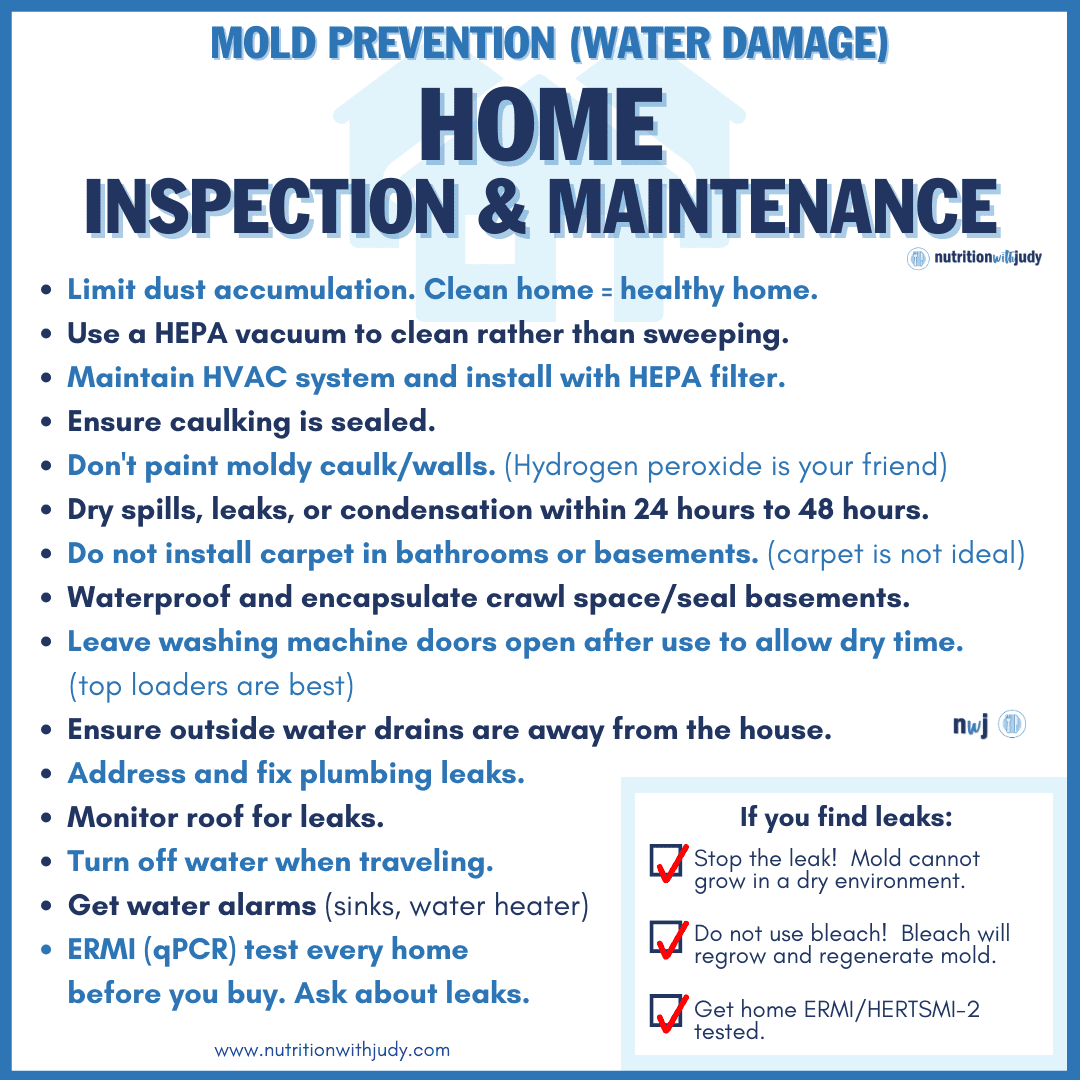

Water leak alarms are a great low-cost addition for peace of mind. These can be placed anywhere you have plumbing and alert your phone if it senses any water. They can also be hooked up to smart water shut-off valves that automatically shut off your main water line if a leak is detected.
Indoor Humidity
Keep humidity levels low. The ideal range is between 30% and 50% for indoor humidity. Anything above 50% creates an environment for mold to grow within only 48 hours. When humidity levels are below 30%, this can cause higher amounts of dust to settle. However, it’s essential to prevent indoor humidity from going above 50% as mold thrives in moist environments. Dehumidifiers and/or air conditioners, especially in areas that tend to be more humid, such as basements and bathrooms, are ideal. Use hydrometers to monitor humidity levels on each level of your home. Attached garages should be monitored and maintained, too.
Ventilation
Proper ventilation helps prevent mold growth– make sure to keep your home or building well-ventilated. Use exhaust fans in your bathroom and kitchen. If you do well outside your home, don’t have any environmental allergies, and aren’t worried about potential contamination from your neighbor’s homes, you can consider opening your windows on dry days to improve air circulation. Homes that are built as energy-efficient often have issues with ventilation and keep poor indoor air quality inside– find ways to ventilate your home better if that’s the case. Keeping ceiling fans and other indoor fans on can also help mitigate stagnant air to help prevent mold growth.
Maintenance Tips
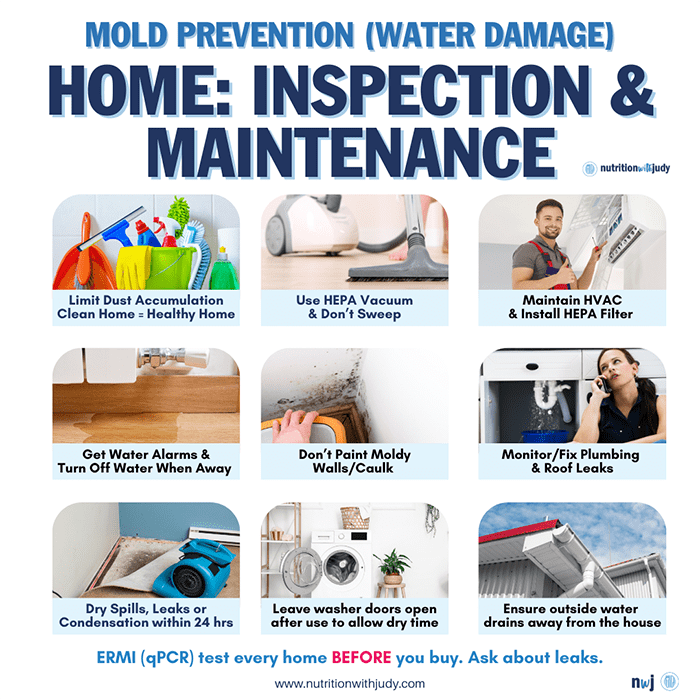

Air Purifiers
Using a high-quality HEPA air purifier rated down to 0.1 microns in conjunction with activated carbon filters is essential for ongoing maintenance. AirOasis is one of the favorites used for mold illness as it’s been shown to improve VCS scores for mold illness patients in less-than-ideal environments.
Cleaning
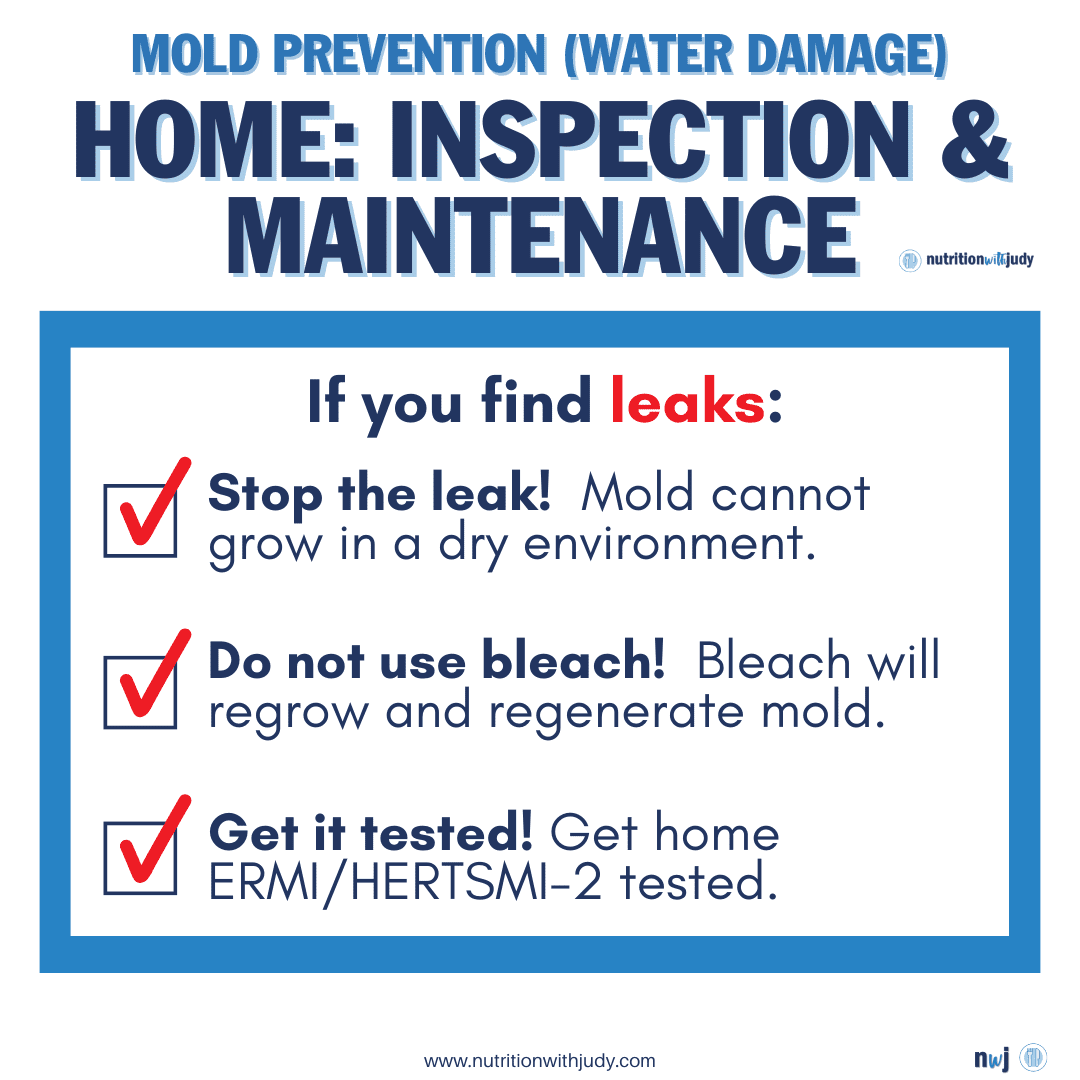

Limit dust accumulation. Dust is essentially food for mold, so the cleaner the home, the healthier it is. HEPA vacuums are also required to ensure all dust is properly removed and not recirculating in the building. Opt for HEPA vacuuming over sweeping and non-HEPA vacuums. Consider creating a weekly cleaning schedule that’s sustainable long-term while minimizing dust on all surfaces and flooring as much as possible.
Hydrogen peroxide is the ideal option for cleaning small amounts of mold. Bleach should never be used unless you’re working directly with a Shoemaker IEP that can ensure the proper application is being used. But if there is enough mold (e.g., beyond a little visible on your shower caulking), you’ll need to contact an IEP for proper mold remediation.
Mold Prevention Products
It can be tempting to try mold prevention products such as ozone, fogging, EC3 candles, UV light sanitization, and anti-fungal paints. These should never be used as they kill or denature the mold in your building, causing the spores to fracture into smaller fragments that are just as inflammatory and toxic to those with mold illness.
Other Miscellaneous Tips
Beyond proper cleaning, having a deep cleaning schedule for your appliances, and regular home inspections and maintenance, there are some other tips to consider for keeping the mold levels in your building safe:
- Maintain your HVAC system with regular inspections and annual cleaning
- Window and wall AC units should be monitored and replaced frequently. Some IEPs recommend every couple of years, but this will depend on your environment.
- Use a MERV 12 to 15-rated HEPA filter and change it more frequently than recommended
- Ensure all caulking is sealed inside and outside
- Pay special attention to caulking behind the bathroom and kitchen sinks against the backsplash is monitored. Water can seep into the caulking even with a pinhole opening, causing mold on the back of the cabinetry.
- Wipe down any excess water after washing your face, brushing your teeth, doing the dishes, or getting out of the shower
- Avoid carpets if possible, opt for area rugs that can be washed instead
- Waterproof and encapsulate crawl spaces and seal basements
- Leave washing machine, dishwasher, and shower doors open after use to allow drying time (Shower curtains should be fully expanded to dry and should also be replaced often)
- Ensure proper water drainage outside of the home – consider landscaping and keeping gutters clear
- Monitor the roof for leaks and ensure gutters are clear
- Turn off the water when traveling
- Limit EMFs within the home, as they can exacerbate mold growth (turn the router and Bluetooth functions off at night)
Pro Tip: If you want comprehensive, in-depth resources and a community supporting your mold illness journey, join the NwJ CIRS Group.
Closing Thoughts On Mold Illness
Mold illness, like any environmental illness, is complex and can be overwhelming. However, the diagnosis is often a source of hope for those suffering from chronic illness, providing a path to root-cause healing that was never available before. It’s so important to continue supporting your mental health as you embark on your mold illness treatment and just focus on one step at a time to avoid the overwhelm.
If you’ve been on the carnivore diet for more than six months and still can’t regain your full health, we strongly encourage you to look into mold illness and the diagnostic criteria for CIRS. If you’re on the fence and aren’t sure if you should pursue the mold illness route, our team is always here to help.
Work With Our Trusted Mold Illness Support Experts
The Nutrition with Judy Team is honored to be the trusted mold illness support experts serving clients from around the globe. We’re passionate about helping our clients achieve root-cause healing in order to lead the best quality of life possible that’s nearly symptom-free. Our team is always available to help you with any questions you may have regarding mold illness and CIRS. We welcome you to explore our free resources and are always available to support you through personalized protocols.
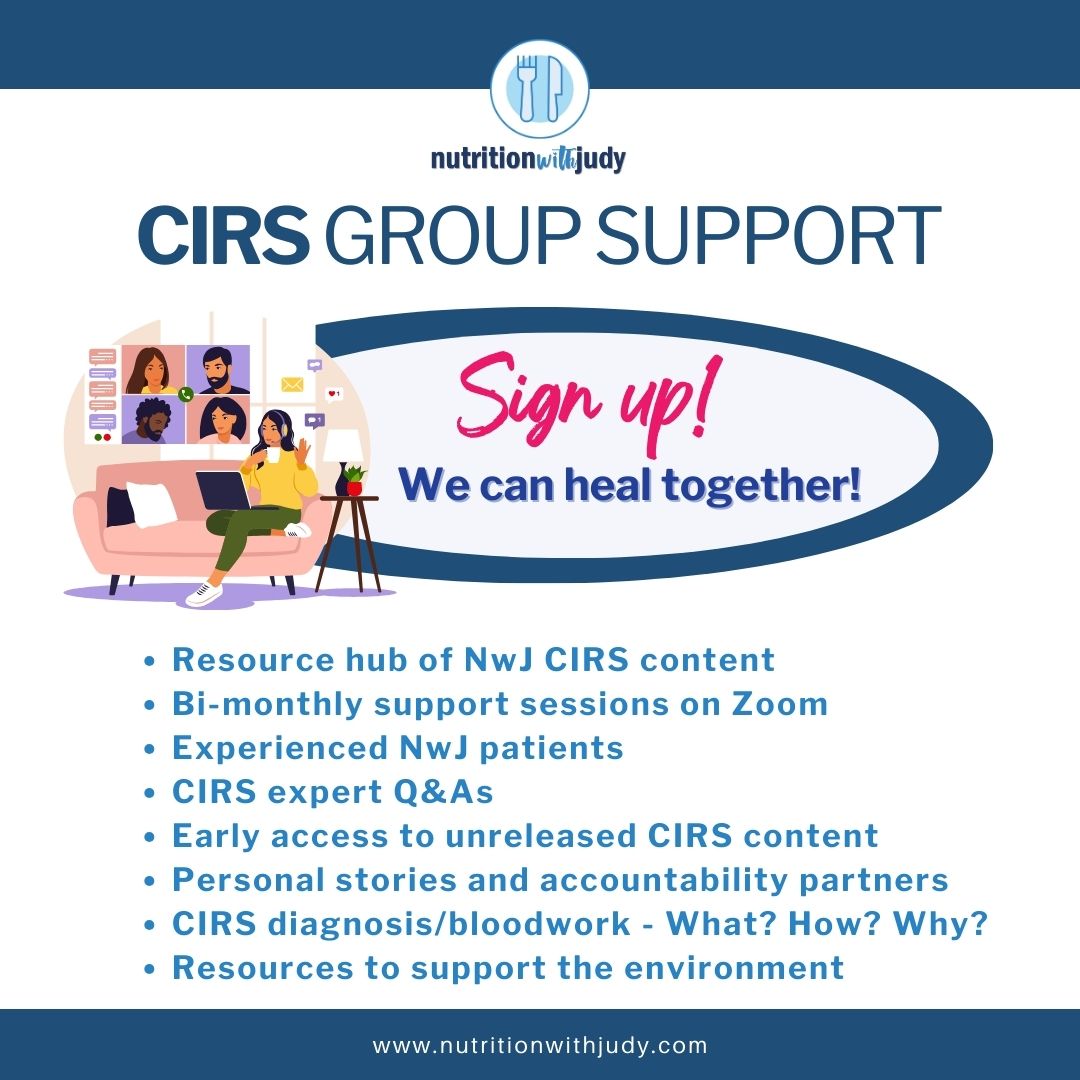

For individuals seeking comprehensive practitioner-led and community support on their mold illness journey, we welcome you to join our exclusive NwJ CIRS Group Support. Join today for access to extensive resources, a like-minded community, and unparalleled care as we journey to root-cause healing together.
Start your healing journey today and contact us any time with any questions or concerns.
DISCLAIMER: This content is for educational purposes only. While we are board-certified in holistic nutrition and are nutritional therapy practitioners, we are not providing medical advice. Whenever you start a new diet or protocol, always consult with your trusted practitioner first.


